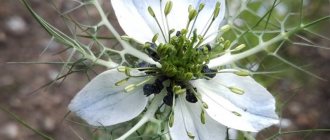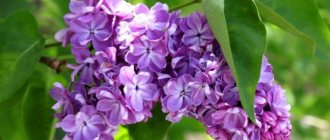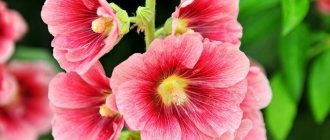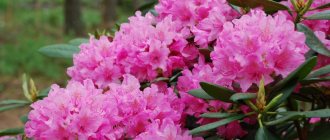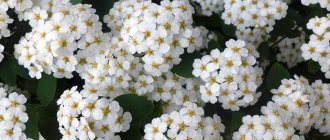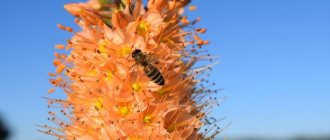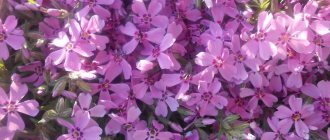Lagerstroemia or Lagerstroemia is a genus of about 50 species of flowering, deciduous or evergreen trees and shrubs that grow naturally in Southeast Asia, northern Australia and the islands of Oceania.
Lagerstroemia received its name in honor of Magnus von Lagerström, a Swedish merchant who was one of the main suppliers of plants to the famous naturalist Carl Linnaeus.
In garden culture, of all species, Indian lagerstroemia (Lagerstroemia indica), also known as Indian lilac, has become widespread.
In its homeland in China, it was known thousands of years ago and was especially loved by representatives of the Tang dynasty, who ruled from 618 to 906 AD.
This species is characterized by compactness, high decorativeness and is the progenitor of many highly decorative garden hybrids.
Description
The ornamental garden plant Lagerstroemia indica grows well in the Mediterranean, in the south of Ukraine and Russia. A deciduous shrub or tree is covered with many “corrugated plates” of various colors and shapes, collected in dense tassels.
The leaves are simple, with full margins, different sizes 5–20 cm, oval, elliptical. In autumn, the green leaves turn gold, orange, red or purple before falling. Some varieties have dark burgundy and even almost black leaves.
The flowers are 2.5 cm in circumference, with wavy edges, and are a panicle of ruffled flowers with a crepe texture. The colors are white, pink, raspberry, lilac, red and almost every shade in between. While there is no such thing as orange, yellow or pure blue, there is still a tendency towards the blue end of the spectrum.
Lagerstroemia grows well in the southern regions of our country
Lagerstroemia lilac has a wiry, grooved stem and spotted branches due to peeling bark. In Crimea, it can withstand frosts down to -10°C, provided that the shoots have time to become lignified. In hot, dry summers, the plant needs to be watered regularly. Grows best in fertile, well-drained soils and does not tolerate salinity. Tall trees reach 25-30 meters.
Sometimes lagerstroemia grows to the size of a tree
All diversity is divided into:
- Species: Inflorescences are looser than those of varietal ones. The leaf is long, oblong, pointed. The crown is branched. The smooth light bark of the trunk resembles coffee with milk.
- Varietal: with oval leaves and dense, dense inflorescences of rich colors. For example: Red Rokket - with bright scarlet inflorescences.
Cherry Dazzle - translated as dazzling cherry, also red. Short. The leaves are small, bronze, then darken, turn green, and turn red in the fall. Small flowers with round frilly petals are collected from pink and red inflorescences.
The crown of the variety is dense, self-branching. The branch, stopping in growth, sends out shoots from all the axils, and the plant turns out to be as thick as a Christmas tree. And it is noteworthy that each one grows with a bend to the side. The variety is not afraid of disease and drought.
Lagerstroemia Cherry Dazzle
Phlox paniculata
Phlox is a herbaceous perennial of the Sinyukhov family. The erect stems of the plant reach a height of 150 cm. Paniculate phlox is similar to lilac with its long inflorescences growing densely on each stem-peduncle.
The flowers of the plant are colored pink, lilac, purple, red, and there are many varieties with two-color petals. The habitat of wild phlox is southeastern North America (except Florida).
Types and applications
There are more than 25 species. Most grow in China, Korea and Japan. Lignified branches are super-strong and hard raw materials; they are used to make furniture and railroad ties. In its climatic zones, the plant is distributed in various types of landscapes; The leaves are used to feed larvae in the production of valuable Toscara silk.
Indian
The most common type, the shoots are thin, with a shiny, glossy skin. The leaves on the branches are attached to small cuttings. They are dark olive, dense, have a fleshy structure, round closer to the stem and pointed in the other direction. During flowering, they are practically invisible behind the lush inflorescences.
The inflorescences of densely growing flowers resemble a 20 cm pyramid. The buds resemble balls and gradually bloom from the bottom. In a flower of several wavy petals with a fringe of eyelashes, it blooms into a double miracle, reminiscent of a miniature rose. Bright yellow stamens are visible in the middle. The lush splendor of different flowers shower the bush. Has high adaptive abilities.
Lagerstroemia indica
Guilinensis
The shoots are thin and smooth. The leaves are small, rich green, shiny, about 6 cm. The leaf is wedge-shaped or rounded, the apex is pointed. The petals are one and a half centimeters white and grows on limestone mountain soil.
Lagerstroemia Guilinensis
Felt (tomentosa)
The branches are covered with a gray, fibrous layer of bark. Shoots and leaves have golden skin. The leaves are glossy and pointed. The petals are round, the color varies from white to pink and purple.
Tailed
The branches are smooth, with widely scattered leaves. They are located on legs measuring from five millimeters to a centimeter. The leaves are oval or elliptical, can be either bare or pubescent on the outside, up to 5 cm in size. The leaves are the same shape as the previous variety. The sepals are small, with a glossy surface.
Petals are white, oblong (1 cm). It blooms and produces fruits from early April to late October. This species is found in forests, forest edges, and hills. Other popular varieties of Lagerstroemia: Cordon Bleu, Dynamite, White Chocolate, Light Pink, Graceful Banaba.
All species need warmth, watering, good insolation and regular feeding. To give beautiful lines to a bush or tree, pruning should be done once a year. Domestic species urgently need a warm winter.
The inflorescences of caudate lagerstroemia are collected in peculiar tassels (tails)
The best lilac in perfume: the most popular scents with names and descriptions
We present a list of the most famous sounds that have a huge number of fans.
Lilac Path by Aerin Lauder
Lilac bushes growing in the garden of the perfumer’s grandmother, Irene Lauder, inspired her to create this wonderful composition. It clearly contains notes of galbanum, angelica, jasmine and orange blossoms. This complex gives all women the opportunity to plunge into memories of the warm season, keep spring on their dressing tables and enjoy its scent even in winter.
Eau de toilette with the aroma of lilac is suitable for both older women and very young people. It will help every girl understand how lovely she is and will cheer her up for the whole day.
Gucci Guilty Intense
The perfume will give its owner universal attention and admiration. It is perfect for bright and bold young ladies who love to enjoy every second.
The interweaving of tangerine shades with heliotrope and violet, as well as an increased concentration of pink pepper with notes of lilac, made the perfume more piquant and sensual. And the motifs of patchouli leaves and amber in the drydown only increase their provocativeness.
Guerlain Idylle Love Blossom
You can talk about love forever. And the versatility of this condition will not allow it to happen again. The same thing happens with the compositions: each of them shows its own, new vision of this beautiful human feeling.
The idea of blossoming love was proposed by the fashion house Thierry Wasse. The bottle of this creation follows the delicate curves of the female body, and the magical contents reveal a sophisticated character with just one drop.
The light floral perfume contains not only lilac, but also lychee and Bulgarian rose. Moving into a passionate whirlwind of “heart” notes, the owner will hear the sensual shimmer of jasmine. But soon the bright melody of flowers subsides and gives way to velvety patchouli leaves and tart musk.
Sheer Beauty Essence by Calvin Klein
A soft and fragrant bouquet is designed for romantic natures who love to be in the clouds. Water can emphasize the femininity of any girl, reflecting elegance and tenderness in her image.
The sound belongs to the category of floral-fruity and has rich woody tones. The lilac-flavoured perfume is complemented by pear and white peach aroma. The “heart” contains attractive chords of peony, fragrant rose and magnolia, and in the trail you can hear pine cedar motifs mixed with a vanilla-musk cocktail.
Lilac by Demeter
The New York-based brand has become known for its one-note products. Over 20 years of experience, the company has produced about 265 mono-flavors. Among them there is the smell of vinyl, wine and lime, donut, first kiss, Times Square, Cuba, sun. Of course, perfumery has not avoided fragrances with a note of lilac. It is perfect for ladies who adore this flower and want to feel exclusively its sound.
White Lilac & Rhubarb by Jo Malone
This is a gentle composition that personifies spring and is filled with romance and femininity. The sonorous melody of this floral creation consists of alluring and eye-catching shades of rose and spicy rhubarb. And the heliotrope that complements them gives the water depth and powderiness.
Perfume with the scent of white lilac is called a triumph of contrasts, which is due to its bitterish-delicate composition. They are made so professionally that the flowers become tangible, as if you could touch them with your hand. Even in winter, it seems that outside the windows there is a warm and sunny May, filled with the fragrance of blooming nature.
My Scent by Trussardi
The perfume creation released by the Italian brand is dedicated to eternal beauty. The elegant iridescent bottle represents a dreamy, romantic and sensual woman, just like its contents.
The perfume with notes of lilac, pear, rose, heliotrope and cashmere wood is suitable for beauties who radiate cheerfulness and charm. They can easily turn any man’s head and give themselves over to new feelings.
This eau de toilette hides the vitality that embodies the mysterious feminine form and the kaleidoscope of emotions it evokes.
FleurTeese by Dita von Teese
The bouquet was released in 2013 especially for Women's Day. It was also inspired by the fragrant lilac bush, the shades of its inflorescences found a place both in the design of the bottle itself and in its packaging.
This is the very aroma that reflects the versatility of lilac: from pure and immaculate to seductive. The composition opens with sparkling notes of bergamot, delicate lily and jasmine. Then it smoothly transitions into the next round, consisting of iris, spicy heliotrope and “hero of the occasion”. The melody ends with a persistent sandalwood-musk trail mixed with hints of cedar.
The creator of this perfume creation, Dita Von Teese, is a determined and charming lady. And the perfume reflects her romantic side: they are filled with passion, the incense of blooming spring plants, as well as the style of the master himself.
Desarmant by La Perfumerie Moderne
The perfume belongs to the family of floral woody musk and was developed in 2013. Velvety floral accords make it sound powdery, and its warmth will complement the image both in everyday life and at evening events.
Here you can clearly hear notes not only of lilac, but also of expensive leather, moss and sweet vanilla, as well as animalistic motifs. Therefore, it will be an excellent gift for both the woman and the man you love: everyone will find their own nuances in it.
A Lilac Day by Vilhelm Parfumerie
The 2016 fragrance is produced on the basis of natural, freshly harvested raw materials. It literally intoxicates with lilac shades, complemented by a bouquet of freesia, galbanum, jasmine, fragrant rose and amber.
But it is no coincidence that this beloved flower is in the center of the composition. After all, it is a symbol of the first moments of love, and in Celtic mythology it is believed that it attracts spring - a period of rebirth and abundance.
Eclat d'Arpege Lanvin
The perfume belongs to the group of floral fruity perfumes and was released in 2002. They became the successors to another famous sound, which at that time was 75 years old.
Perfumer Alber Elbaz tried to make the melody fresher and younger. She embodies the crystal drops of morning dew on the blossoming petals of plants. Thanks to this airiness, the water is perfect for any occasion.
At the beginning of the bouquet you can hear notes of tea and lilac inflorescences. Then the color of peach and noble peony appear. And at the end there is a trail of coniferous cedar, languid amber and osmanthus.
Reproduction
- The seeds are sown in moist soil to a depth of about a centimeter and covered with a glass or film cap. This is done at an ambient temperature of at least 24 ° C, and full sunlight is also needed. Periodically needs watering and ventilation.
After two weeks, sprouts will appear from the soil. Afterwards they are planted in pots. Sprouts obtained in this way lose their varietal qualities during cross-pollination, so Lagerstroemia seeds must be purchased in specialized stores, research institutes, and private breeders.
It is possible to grow lagerstroemia from seeds
- Cuttings are separated in the spring. The lignified shoot is cut from the trunk and placed in a mixture of peat and sand. Several branches are planted in a pot at once. The dishes with cuttings are covered with a transparent bag and ventilated from time to time. The first roots will appear within 20 days.
- Division. Basal shoots are separated from the mother plant in the spring during replanting. The main thing is that he has already acquired his own roots. Planted in a light substrate, slightly moistened and placed in a warm, shaded place. When the plant gains strength, it is transferred to a permanent place.
Home care
Lagerstroemia requires careful care, otherwise the flowering will be weak and short-lived. In addition, the pet needs rest - if it does not shed its leaves, it will not gain strength by spring. Compliance with the watering regime is one of the most important conditions for caring for Indian lilacs.
You can’t overdry it, otherwise it will drop its buds, and if you don’t water it for a long time, it will drop its leaves. And vice versa, in the case of flooding, mold appears, which is harmful to the plant. It is recommended to water once a day, and twice in the summer, spraying if necessary. When the growth period ends, watering is reduced.
In winter, maintain soil moisture so that it does not dry out. When the plant is watered, it is transferred to a warm place for one to two hours. You need high-quality water, soft and free of impurities. If possible, the water is filtered; if not, it is recommended to stand.
If the air in the room is dry, the foliage is sprayed every day, in the morning or evening. The procedure is carried out during the cold period, if the plant has not lost its leaves. During the period of growth and development, room temperature is ideal for the oriental beauty. In winter, you need coolness, about 10 ° C.
An insulated loggia or veranda on the southeast and southwest sides is well suited - the plant needs a lot of light. In the shade, the shoots will stretch out and flowering will deteriorate. Lagerstroemia tolerates short-term frosts down to -5°C on the balcony and up to -10°C outside.
Adviсe
How to grow lilacs from a twig in a pot? The procedure is performed as described above, you only need to select a container - it can be a plastic or ceramic pot. It is important to follow the sequence of actions, as with classical planting, only then can you expect excellent results.
It is easier to grow in a greenhouse, since the greenhouse effect allows you to create ideal conditions. In addition, the humidity is quite suitable for the root system. In winter, the plant must be covered with spruce branches. For several years, the bush should be loosened, weeded, and be sure to add fertilizing. Compost and humus can serve as fertilizer. Proper care ensures excellent growth and luxurious flowering.
3 methods: Planting lilacs Caring for lilacs Cutting and drying lilacs
Imagine, inhaling deeply, the mysterious aroma of lilac wafting through the curtain of a warm summer evening. Lilacs are not difficult to grow if you give them plenty of water and plant them in full sun. There are over 100 species of lilacs that grow as bushes or trees and produce fragrant flowers. Read on to learn how to grow and care for lilacs.
Trimming
The tree grows quickly, and inflorescences appear only on young branches. Therefore, pruning is done every year in the fall. The shoots are cut to 20–30 cm. If the plant is a tree, one developed shoot from the root is left, the others are removed. If a shrub is formed, there are several main shoots. Damaged, broken off, growing inward and thickening the crown are also removed.
Soil and fertilizing. Grows well in store-bought, all-purpose potting mix for flowering plants. The drainage layer is a quarter of the total volume. It is possible to create the soil for planting yourself - equal proportions: sand, turf and deciduous soil. The substrate must be loose - this is important! Fertilizers are applied during the period when the plant blooms. In the spring, liquid complex fertilizer and fertilizing are applied.
Transfer. On average, the plant is moved to another container in the spring every 2 to 3 years. The container for transplantation should not be too large, but high enough. A gentle way is to reload or renew the top layer of soil (it does not tolerate the procedure well).
Diseases, pests and problems
The eastern beauty is sick and rarely exposed to pests. The main pests for the plant are aphids and red mites. There is still a risk of exposure to mold and powdery mildew indoors. This is where fungicidal preparations come to the aid of gardeners. For preventive purposes, you need to regularly ventilate, water, and use a ventilated substrate.
Problems of gardeners when growing:
- Insufficient number of flowers and stretching of shoots due to lack of light, low temperatures, lack of rest in winter;
- Improper pruning will not produce inflorescences;
- Falling leaves and flowers in summer means lack of moisture;
- If it died, it was due to excessive watering, dry soil, or low temperatures.
Flowers similar to lilac: Review +
Everyone knows the beautiful and fragrant lilac. A beautiful shrub with small flowers and a pleasant scent.
Lilac has always been a decoration of any garden. Flowers come in a wide variety of shades - white, purple, blue.
Interesting facts about lilacs
Lilac is a long-liver. She lives more than 100 years. Lilac oil is worth more than the price of gold.
It is important to know! The smell of lilac can cause severe headaches. Lilac flowers contain toxic and harmful substances. Lilacs are trimmed only with a sharp tool, even its flowers. If you pick flowers with your hands, the lilac bush will begin to hurt and wither.
Cut lilacs very quickly lose their beautiful appearance. Despite all its toxicity, lilac is actively used in folk medicine. It is used for rheumatism and for wound healing. There are different types and varieties of lilac. They differ from each other in flower shades, sizes, appearance, and flowering duration.
! Did you know that Hungarian lilac has no smell at all?
It is interesting that in nature there are like plant counterparts. And many are not always able to distinguish one plant from another. Flowers can be very similar to each other in size, color, and inflorescences. But at the same time, they most likely belong to completely different species and families. And this is truly amazing.
Lilac is no exception. This plant also has so-called doubles. There are different plants that are sometimes confused with lilacs, or have many similarities. This article will look at the plants that are most similar to lilacs.
Growing lagerstroemia in open ground
Lilac has amazing properties: the inflorescences change color; one plant can produce several shades at once. By dawn, the pleasant aroma of flowers intensifies. In order for lagerstroemia to bloom beautifully, you should adhere to the following rules:
The place should be very well lit. Other plants may suffer at such temperatures, but lagerstroemia is comfortable. Such active sun is necessary for lush flowering.
Ordinary black soil, for all its advantages, is not suitable. To achieve good growth, you need to mix the soil with sand. You will get the desired composition.
Warm winter. If the lilac grows in a tub outside, it is brought into a cool room after the leaves fall, where it is left for the winter. Watering once a month is acceptable.
In April-May, when it gets warmer, the plant is moved outside. If lagerstroemia grows in open ground , then by winter it is pruned, hilled and covered with spruce or sawdust. When the soil warms up enough, the shrub will begin to actively grow again.
Skimmia
This plant of the Rutaceae family is a perennial shrub. Skimmia leaves are dense, wide, dark green in color. The plant produces lush spherical inflorescences; in August, red berries are formed from the flowers.
Skimmia differs from lilac in the shape of flowers and inflorescences, as well as in the formation of berries. Decorative skimmia flowers are dark red, red, white, pinkish. The habitat of wild species is the mountain forests of southeast Asia and the Japanese islands.
